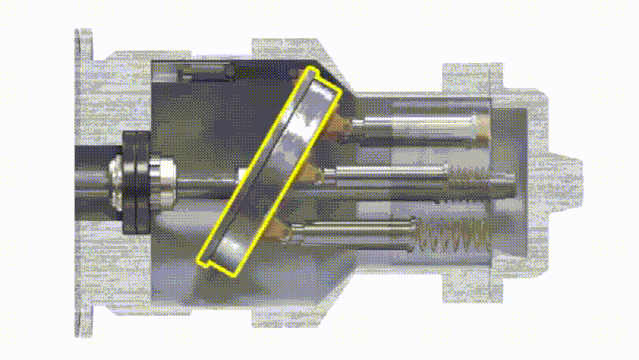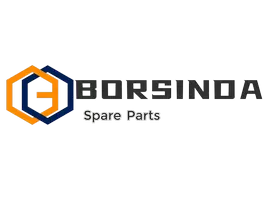Working Principle of Hydraulic Pumps

A hydraulic pump converts mechanical energy into hydraulic energy by periodically changing the volume of sealed chambers, allowing it to suction, compress, discharge, and circulate oil within a hydraulic system.
Hydraulic pumps are classified as positive displacement pumps, meaning they move a fixed amount of fluid per cycle, ensuring a steady and efficient hydraulic power supply. The type of pump and its pump design determine how fluid is moved, the pressure generated, and how efficiently the system meets varying load requirements.
1. Suction Stage (Low-Pressure Intake)
Volume Expansion and Negative Pressure Formation
- Drive Shaft Movement: The prime mover (such as an electric motor or internal combustion engine) rotates the pump shaft, causing gears to rotate, vanes to move, or pistons to retract. This movement increases the pump chamber volume, creating a vacuum.
- Negative Pressure Zone: As internal pressure drops below tank pressure (near atmospheric pressure), a negative pressure zone forms, drawing oil into the pump chamber.
Oil Inlet Path
- Inlet Check Valve: Oil enters through an inlet check valve or open channel.
- Specific Pump Actions:
- Gear Pump: The gear disengagement side expands, forming a suction chamber.
- Hydraulic Piston Pump: Pistons retract, increasing chamber volume and pulling in hydraulic fluid.
2. Compression Stage (Pressure Increase)
Volume Reduction and Oil Compression
- Continued Movement of Mechanical Components: The rotating or reciprocating motion of the pump reduces the sealed chamber volume, compressing the oil.
- Specific Pump Actions:
- Hydraulic Piston Pump: A swashplate or cam mechanism pushes pistons forward, reducing chamber volume and increasing pressure.
- Vane Pump: The eccentric rotor compresses the oil chamber as vanes retract.
Check Valve Flow Control
- Inlet Check Valve Closes: As pressure rises, the inlet check valve closes to prevent backflow.
- System Demand Pressure Achieved: Pressure builds up to the required level, determined by load requirements and system operation needs.
3. Discharge Stage (High-Pressure Output)
High-Pressure Oil Delivery
- Outlet Check Valve Opens: Compressed, high-pressure oil flows through the outlet check valve into the hydraulic system.
- Discharge Pressure Determinants: Factors such as pump design, gear meshing precision, piston stroke, and type of pump influence the final discharge pressure.
Power Transmission to Actuators
- Hydraulic Fluid Movement: The high-pressure oil drives actuators, such as cylinders and motors, enabling mechanical motion.
- Specific Pump Characteristics:
- Gear Pump: Provides continuous flow, though pulsations may occur.
- Hydraulic Piston Pump: Offers smooth discharge, adjustable pressure, and is often a variable displacement pump, meaning flow and pressure can be adjusted based on system demand.
4. Unloading Stage (Pressure Release and Recirculation)
Pressure Equalization and Oil Return
- Residual Pressure Release: After discharge, the pump chamber connects to the oil tank through internal channels or external circuits, allowing pressure to equalize.
- Oil Returns to Tank: Some systems include dedicated return paths to recirculate oil.
Sealing and Efficiency Factors
- Sealing Methods:
- Gear Pumps rely on tooth flank clearance to prevent leakage.
- Vane Pumps use vanes pressed against the stator for effective sealing.
- Key Influencing Factors:
- Volumetric Efficiency: Determined by how well the chamber is sealed. Excessive leakage lowers pressure and efficiency.
- Drive Method: Prime movers, such as electric motors or combustion engines, influence pump speed and performance.
- Oil Properties: High-viscosity oil can create suction difficulties, while low-viscosity oil may increase internal leakage.
Comparison of Typical Pump Types
| Type of Pump | Suction Action | Discharge Action | Pressure Characteristics |
|---|---|---|---|
| Gear Pump | Gears rotate, creating suction on the disengagement side | Gears mesh together, compressing and discharging oil | Medium-low pressure, noticeable pulsation |
| Vane Pump | Centrifugal force extends vanes, forming a suction chamber | Vanes retract, compressing the oil chamber for discharge | Medium pressure, uniform flow |
| Hydraulic Piston Pump | Pistons retract, drawing in oil | Pistons advance, compressing oil | High pressure, adjustable flow (variable displacement pumps allow for output control) |
Conclusion: How Does a Hydraulic Pump Work?
Understanding how does a hydraulic pump work is crucial for selecting the right type of pump for industrial applications. A hydraulic pump plays a vital role in converting mechanical power into hydraulic energy, ensuring consistent power delivery to actuators. Positive displacement pumps, including gear pumps, vane pumps, and hydraulic piston pumps, each offer unique benefits based on load requirements and system operation.
Among these, variable displacement pumps provide flexibility by adjusting flow and pressure according to system needs, making them ideal for high-performance hydraulic systems. Whether in construction, manufacturing, or automation, choosing the right pump design ensures efficiency, reliability, and longevity in hydraulic applications.
Key Takeaways
✅ How does a hydraulic pump work? – It converts mechanical power into hydraulic energy through suction, compression, discharge, and circulation.
✅ What influences hydraulic pump performance? – Pump design, type of pump, load requirements, prime mover, and volumetric efficiency are key factors.
✅ What are the best pump options? – Positive displacement pumps like gear pumps, vane pumps, and hydraulic piston pumps, with variable displacement pumps offering the most flexibility.



